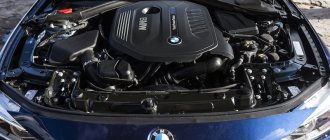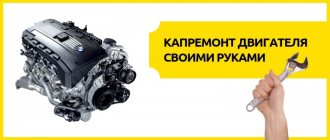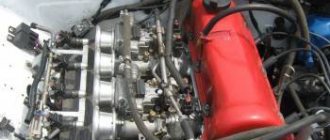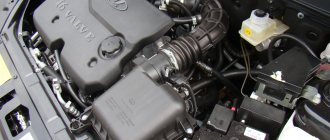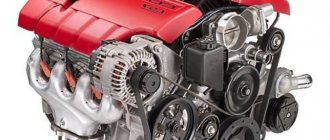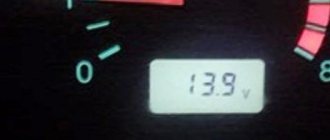Horsepower (hp) is a non-system unit of measurement of power. Currently, it has officially been phased out in Russia (the standard SI unit for expressing power is the watt), but still continues to be widely used in the auto industry as an indicator of engine power.
In 1789, Scottish engineer and inventor James Watt coined the term "horsepower" to indicate how many horses his steam engines could do.
You should know that horsepower is not the maximum, but the average indicator of the power a horse can maintain for a long time. For a short time, the average horse can develop a power of about 1000 kg * m / s, that is, the power of one horse is 13.3 horsepower.
Basic units of engine power and their designation
1. Horsepower (735.49875 W). Denoted as: hp (this is netto engine power, measured using engine auxiliary units, such as muffler, generator), bhp (this is gross engine power, measured without the use of additional units).
You can also find other designations: PS (German), CV (French), pk (Nid.).
In English-speaking countries, horsepower is still more often equated to 745.6999 W, which is approximately equal to 1.014 European horsepower.
2. Watt
Since the description of the watt is beyond the scope of this article, we will not touch on it here.
Physical quantities
Contains information about basic, additional and derived units CIF physical quantities| We are on social networks Join us! Found a mistake? Any suggestions? Let us know |
| This calculator can be inserted into a website or blog. We will create a calculator for you |
| Embed code: Copy and paste this code onto your page where you want the calculator to appear. | |
This is interesting: How to turn off the display on a pioneer radio
How is horsepower calculated?
Horsepower is a conventional and ambiguous unit of measurement of power.
In Russia and almost all European countries, horsepower is defined as 75 kg*m/s (metric horsepower), that is, as the power sufficient to lift a load weighing 75 kg to a height of 1 meter in 1 second. In this case, 1 liter. With. is exactly 735.49875 watts.
The maximum power that a horse can develop is usually called boiler horsepower. You can easily calculate your maximum power. To do this, you need to measure the time t during which you run up the stairs of height h and substitute it into the formula: m*h/t, where m is the mass of your body.
To determine engine power, special stands are used, more about this is written below.
What it is
Not everyone knows why engine power is measured in horsepower. There's actually quite an interesting story here.
Many will be interested to know where this unit of measurement came from and why it’s all about horses. A lot of this has to do with marketing their time. Thanks to him, we currently measure the power of power units in horsepower. Now it’s worth telling why this happened.
Such a unit of measurement as LS was introduced back in the 18th century by James Watt. It is in his honor that another unit is named, that is, Watt.
Back in the 70s of the 18th century, he created the first steam engine, which significantly surpassed in its technical parameters the steam installation invented by Newcomen. At the same time, Watt did not know how to sell his development better and more profitably. One of his arguments was the fact that his engine needed 75% less fuel to operate.
Initially, the sale was carried out according to a somewhat unusual scheme. Customers who bought an engine gave away a third of the money they saved on fuel. But those times were a period when horses dominated the world of transport. As a result, few people were interested in steam engines.
As a result, Watt decided that it was necessary to compare his engine not with another steam unit, but with animals. As a result, his sales scheme was canceled and James tried slightly different sales tactics. He wanted to convince people to buy his engine.
This is how the unit of measurement that we all know today as horsepower was invented. This decision was made due to the fact that the client intuitively understood what was at stake when comparing the capabilities of a steam plant and a workhorse. In fact, it was a clever marketing ploy. But Watt supported his words with appropriate calculations.
He took an average workhorse as a basis and calculated how much energy it was capable of producing. No one knows exactly what experiments his calculations were based on. But it was found that in 60 seconds of work a horse produces approximately 45 thousand joules. And this corresponded to one horsepower.
In reality, the results turned out to be somewhat overestimated. Rare horses could work in this mode for a whole day. But realizing that the capabilities of animals were overestimated, Watt became convinced of the higher productivity of his development. This is exactly what he began to actively tell potential buyers about.
The story is unusual and quite interesting. But the fact is that such a cunning marketing move ultimately turned into a kind of revolution. Watt's engine played a huge role in the further development of the industry, and its advertising horsepower became a standard unit of measurement.
How is engine power measured?
Engine power is measured mainly to assess the effectiveness of tuning.
To determine engine power, there is only one accurate way: remove it from the car and install it on a special stand. Removing and installing an engine is a rather labor-intensive and expensive process that only automakers and serious racing teams can do.
For a less accurate measurement of power, dynamometer power stands are used (such as in the photo), which allow you to take readings “from the wheels”. The result can be influenced by: tire pressure, their grip properties, tire temperature (during measurement the tread gets very hot) and even the degree of attraction of the car with safety lines.
Measuring technique
The warmed-up car starts in first gear, accelerates to 40–50 km/h, after which the last gear is engaged, the gas pedal is pressed all the way and acceleration simulation begins. Upon reaching maximum speed (from the moment the power drop begins, visible on the monitor), neutral gear is engaged.
The measurement result is displayed in the form of a graph that shows the dependence of power on engine speed (blue curve - in horsepower).
Torque
If expressed in the language of physics, the concept of torque is easy to understand if you know the principle of obtaining advantage from the use of a lever. Calculated by adding the forces applied to the lever (the weight of the load) to the length of the arm (lever), “Newton meters” show the potential amount of work performed. In the case of an internal combustion engine, the weight of the load is the force with which the piston moves back and forth after combustion of the fuel-air mixture. The length of the arm will be nothing more than the stroke of the piston (distance from TDC to BDC). Rotating force is created only during the power stroke.
Scale giving an approximate idea of the engine power range
To get an idea of the power range of the engines, please refer to the following figure:
- 0-100 l. With. — small cars;
- 100-200 l. With. - cars with medium power engines;
- 200-500 l. With. — sports cars;
- 500 l. With. and more - racing cars and supercars.
What does the torque shelf depend on?
According to the calculation formula Mkr = F x L, where F is the force and L is the arm length, the torque will depend on the combustion efficiency of the fuel-air mixture (F) and the piston stroke (L).
Since a car is a complex mechanism, engine torque is affected by a number of characteristics of other components and assemblies. The driving wheels of the car will receive maximum traction force only at the moment when the interaction of the mechanisms is optimal. The peak torque is achieved at such engine speeds when the combustion chamber is filled with the working mixture, combustion products are burned and exhaust gases are removed with minimal mechanical losses. For each engine, this parameter varies depending on the design features and the type of fuel used.
Article on the topic: Design and diagnostics of a retractor starter
Table for translation l. With. in kW
To calculate the motor power in kW, you need to use the proportion 1 kW = 1.3596 hp. With . Its reverse form: 1 l. With. = 0.73549875 kW. This is how these two units are mutually converted into each other.
| kW | hp | kW | hp | kW | hp | kW | hp | kW | hp | kW | hp | kW | hp |
| 1 | 1.36 | 30 | 40.79 | 58 | 78.86 | 87 | 118.29 | 115 | 156.36 | 143 | 194.43 | 171 | 232.50 |
| 2 | 2.72 | 31 | 42.15 | 59 | 80.22 | 88 | 119.65 | 116 | 157.72 | 144 | 195.79 | 172 | 233.86 |
| 3 | 4.08 | 32 | 43.51 | 60 | 81.58 | 89 | 121.01 | 117 | 160.44 | 145 | 197.15 | 173 | 235.21 |
| 4 | 5.44 | 33 | 44.87 | 61 | 82.94 | 90 | 122.37 | 118 | 160.44 | 146 | 198.50 | 174 | 236.57 |
| 5 | 6.80 | 34 | 46.23 | 62 | 84.30 | 91 | 123.73 | 119 | 161.79 | 147 | 199.86 | 175 | 237.93 |
| 6 | 8.16 | 35 | 47.59 | 63 | 85.66 | 92 | 125.09 | 120 | 163.15 | 148 | 201.22 | 176 | 239.29 |
| 7 | 9.52 | 36 | 48.95 | 64 | 87.02 | 93 | 126.44 | 121 | 164.51 | 149 | 202.58 | 177 | 240.65 |
| 8 | 10.88 | 37 | 50.31 | 65 | 88.38 | 94 | 127.80 | 122 | 165.87 | 150 | 203.94 | 178 | 242.01 |
| 9 | 12.24 | 38 | 51.67 | 66 | 89.79 | 95 | 129.16 | 123 | 167.23 | 151 | 205.30 | 179 | 243.37 |
| 10 | 13.60 | 39 | 53.03 | 67 | 91.09 | 96 | 130.52 | 124 | 168.59 | 152 | 206.66 | 180 | 144.73 |
| 11 | 14.96 | 40 | 54.38 | 68 | 92.45 | 97 | 131.88 | 125 | 169.95 | 153 | 208.02 | 181 | 246.09 |
| 12 | 16.32 | 41 | 55.74 | 69 | 93.81 | 98 | 133.24 | 126 | 171.31 | 154 | 209.38 | 182 | 247.45 |
| 13 | 17.67 | 42 | 57.10 | 70 | 95.17 | 99 | 134.60 | 127 | 172.67 | 155 | 210.74 | 183 | 248.81 |
| 14 | 19.03 | 43 | 58.46 | 71 | 96.53 | 100 | 135.96 | 128 | 174.03 | 156 | 212.10 | 184 | 250.17 |
| 15 | 20.39 | 44 | 59.82 | 72 | 97.89 | 101 | 137.32 | 129 | 175.39 | 157 | 213.46 | 185 | 251.53 |
| 16 | 21.75 | 45 | 61.18 | 73 | 99.25 | 102 | 138.68 | 130 | 176.75 | 158 | 214.82 | 186 | 252.89 |
| 17 | 23.9 | 46 | 62.54 | 74 | 100.61 | 103 | 140.04 | 131 | 178.9 | 159 | 216.18 | 187 | 254.25 |
| 18 | 24.47 | 47 | 63.90 | 75 | 101.97 | 104 | 141.40 | 132 | 179.42 | 160 | 217.54 | 188 | 255.61 |
| 19 | 25.83 | 48 | 65.26 | 76 | 103.33 | 105 | 142.76 | 133 | 180.83 | 161 | 218.90 | 189 | 256.97 |
| 20 | 27.19 | 49 | 66.62 | 78 | 106.05 | 106 | 144.12 | 134 | 182.19 | 162 | 220.26 | 190 | 258.33 |
| 21 | 28.55 | 50 | 67.98 | 79 | 107.41 | 107 | 145.48 | 135 | 183.55 | 163 | 221.62 | 191 | 259.69 |
| 22 | 29.91 | 51 | 69.34 | 80 | 108.77 | 108 | 146.84 | 136 | 184.91 | 164 | 222.98 | 192 | 261.05 |
| 23 | 31.27 | 52 | 70.70 | 81 | 110.13 | 109 | 148.20 | 137 | 186.27 | 165 | 224.34 | 193 | 262.41 |
| 24 | 32.63 | 53 | 72.06 | 82 | 111.49 | 110 | 149.56 | 138 | 187.63 | 166 | 225.70 | 194 | 263.77 |
| 25 | 33.99 | 54 | 73.42 | 83 | 112.85 | 111 | 150.92 | 139 | 188.99 | 167 | 227.06 | 195 | 265.13 |
| 26 | 35.35 | 55 | 74.78 | 84 | 114.21 | 112 | 152.28 | 140 | 190.35 | 168 | 228.42 | 196 | 266.49 |
| 27 | 36.71 | 56 | 76.14 | 85 | 115.57 | 113 | 153.64 | 141 | 191.71 | 169 | 229.78 | 197 | 267.85 |
| 28 | 38.07 | 57 | 77.50 | 86 | 116.93 | 114 | 155.00 | 142 | 193.07 | 170 | 231.14 | 198 | 269.56 |
Torque to power ratio
To get a clear idea of the interaction of two quantities, consider the main characteristics of the motor on the graph. It shows the engine's power output and engine torque as a function of crankshaft speed.
The graph clearly demonstrates the fact that the traction force on the wheels is not directly proportional to the number of revolutions or power. The engine reaches peak torque at 3 thousand rpm. Maximum power is available at 5500 rpm. In both cases, the speed continues to increase, but the output decreases. For the designated engine, speeds from 2500 to 5 thousand are the most optimal.
In this operating mode, a torque plateau close to the maximum value will allow you to fully realize the potential of the motor throughout the entire segment.
The above graph is an example of civil tuning of modern gasoline engines. The advantages are obvious:
- stable increase in power;
- a fairly wide “shelf” with a smooth rise and fall.
This type of tuning allows you to achieve “elasticity” of the engine. Such work is ensured not only by software (ECU settings), but also by the use of various auxiliary technologies (variable valve timing).
The difference in power characteristics largely depends on the design of the intake and exhaust systems. For example, engines equipped with turbocharging at the boost point receive a significant increase in dynamics. The torque and horsepower of such models significantly exceed their naturally aspirated counterparts.
Article on the topic: What to do if the car door is electrocuted
Energy production
People have long learned to use energy to solve labor-intensive tasks with the help of technology. Potential and kinetic energy are used to do work, such as moving objects. For example, the energy of river water flow has long been used to produce flour in water mills. As more people use technology, such as cars and computers, in their daily lives, the need for energy increases. Today, most energy is generated from non-renewable sources. That is, energy is obtained from fuel extracted from the depths of the Earth, and it is quickly used, but not renewed with the same speed. Such fuels include, for example, coal, oil and uranium, which is used in nuclear power plants. In recent years, the governments of many countries, as well as many international organizations, such as the UN, have made it a priority to study the possibilities of obtaining renewable energy from inexhaustible sources using new technologies. Many scientific studies are aimed at obtaining such types of energy at the lowest cost. Currently, sources such as solar, wind and waves are used to generate renewable energy.
Energy for domestic and industrial use is usually converted into electricity using batteries and generators. The first power plants in history generated electricity by burning coal or using the energy of water in rivers. Later they learned to use oil, gas, sun and wind to generate energy. Some large enterprises maintain their power plants on site, but most of the energy is produced not where it will be used, but in the power plants. Therefore, the main task of energy engineers is to convert the energy produced into a form that allows the energy to be easily delivered to the consumer. This is especially important when expensive or hazardous energy production technologies are used that require constant supervision by specialists, such as hydro and nuclear power. That is why electricity was chosen for domestic and industrial use, since it is easy to transmit with low losses over long distances via power lines.
Transmission pylons near the Sir Adam Beck hydroelectric power station. Niagara Falls, Ontario, Canada.
Electricity is converted from mechanical, thermal and other types of energy. To do this, water, steam, heated gas or air drive turbines, which rotate generators, where mechanical energy is converted into electrical energy. Steam is produced by heating water using heat produced by nuclear reactions or by burning fossil fuels. Fossil fuels are extracted from the depths of the Earth. These are gas, oil, coal and other combustible materials formed underground. Since their quantity is limited, they are classified as non-renewable fuels. Renewable energy sources include solar, wind, biomass, ocean energy, and geothermal energy.
In remote areas where there are no power lines, or where economic or political problems regularly cause power outages, portable generators and solar panels are used. Generators running on fossil fuels are especially often used both in everyday life and in organizations where electricity is absolutely necessary, for example, in hospitals. Typically, generators operate on piston engines, in which fuel energy is converted into mechanical energy. Also popular are uninterruptible power supply devices with powerful batteries that charge when electricity is supplied and release energy during outages.
Florida Power and Light power plant. Port Everglade, Florida, USA. This power plant consists of four blocks and runs on gas and oil.
Energy produced by burning fossil fuels
Fossil fuels are formed in the earth's crust at high pressure and temperature from organic matter, that is, the remains of plants and animals. Basically, such fuel contains a large amount of carbon. When it burns, it releases energy as well as carbon dioxide (CO₂), one of the greenhouse gases. Fossil fuels are the main source of energy at the moment. However, the greenhouse gases released during its use pose a serious threat to the environment and aggravate global warming. Also, the use of this fuel leads to its rapid consumption, and humanity may be left without fuel if it is completely dependent only on fossil raw materials.
Nuclear power plant cooling towers. Photo from the archives of the site 123RF.com.
Atomic Energy
Nuclear energy is one of the alternative types of energy. It is released during a controlled nuclear fission reaction, during which the nucleus of an atom is divided into smaller parts. The energy released during this reaction heats the water and turns it into steam, which drives turbines.
Nuclear power is not safe. The most famous accidents in recent years occurred at the Chernobyl nuclear power plant (NPP) in Ukraine, at the Three Mile Island nuclear power plant in the United States, and at the Fukushima-1 nuclear power plant in Japan. After the Fukushima tragedy, many countries began to reconsider their domestic nuclear energy policies, and some, such as Germany, decided to abandon them. Germany is currently developing a program for the transition to other types of energy supply and the safe closure of existing power plants.
In addition to accidents, there is also the problem of storing spent nuclear fuel and radioactive waste. Some of the spent nuclear fuel is used in weapons production, medicine, and other industries. However, most radioactive waste cannot be used and therefore it is necessary to ensure its safe disposal. Each country that has nuclear power plants stores this waste differently, and many countries have laws prohibiting its import into the country. Radioactive waste is treated so that it does not enter the environment, does not decompose, and is convenient for storage, for example, by making it more compact. After this, they are sent for burial in long-term storage facilities at the bottom of seas and oceans, in geological structures, or in pools and special containers. Storage is associated with problems such as the high cost of processing and disposal, leakage of radioactive elements into the environment, lack of storage space, and the possibility of terrorist attacks at radioactive waste disposal sites.
Nuclear power plant in Pickering, Ontario, Canada
A much safer alternative is to produce nuclear energy through fusion. During this reaction, several nuclei collide at high speed and form a new atom. This happens because the forces that repel nuclei from each other are weaker at a short distance than the forces that attract them. A thermonuclear reaction also produces radioactive waste, but it ceases to be radioactive after about a hundred years, while the waste from a fission reaction does not decay for several thousand years. The fuel required for fusion reactions is less expensive than for fission reactions. The energy costs of thermonuclear reactions currently do not justify their use in the energy sector, but scientists hope that in the near future this will change and nuclear power plants around the world will be able to produce nuclear energy in this way.
